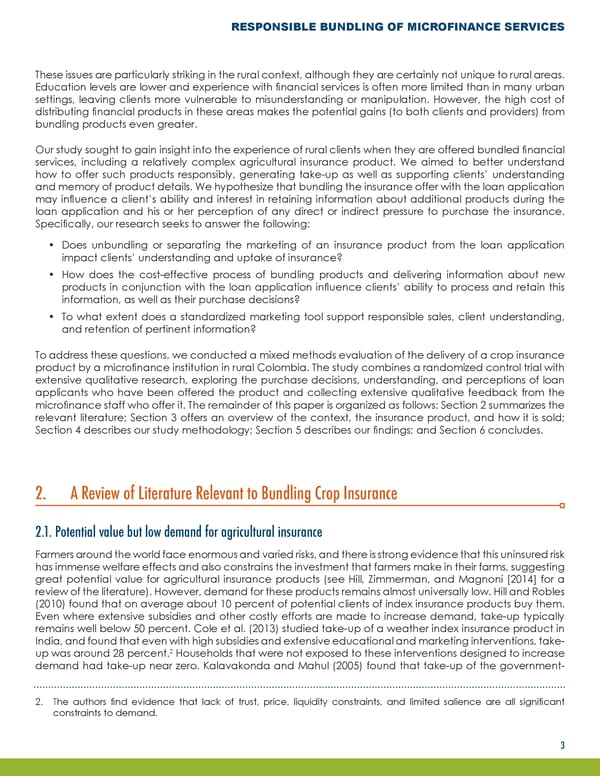RESPONSIBLE BUNDLING OF MICROFINANCE SERVICES These issues are particularly striking in the rural context, although they are certainly not unique to rural areas. Education levels are lower and experience with financial services is often more limited than in many urban settings, leaving clients more vulnerable to misunderstanding or manipulation. However, the high cost of distributing financial products in these areas makes the potential gains (to both clients and providers) from bundling products even greater. Our study sought to gain insight into the experience of rural clients when they are offered bundled financial services, including a relatively complex agricultural insurance product. We aimed to better understand how to offer such products responsibly, generating take-up as well as supporting clients’ understanding and memory of product details. We hypothesize that bundling the insurance offer with the loan application may influence a client’s ability and interest in retaining information about additional products during the loan application and his or her perception of any direct or indirect pressure to purchase the insurance. Specifically, our research seeks to answer the following: • Does unbundling or separating the marketing of an insurance product from the loan application impact clients’ understanding and uptake of insurance? • How does the cost-effective process of bundling products and delivering information about new products in conjunction with the loan application influence clients’ ability to process and retain this information, as well as their purchase decisions? • To what extent does a standardized marketing tool support responsible sales, client understanding, and retention of pertinent information? To address these questions, we conducted a mixed methods evaluation of the delivery of a crop insurance product by a microfinance institution in rural Colombia. The study combines a randomized control trial with extensive qualitative research, exploring the purchase decisions, understanding, and perceptions of loan applicants who have been offered the product and collecting extensive qualitative feedback from the microfinance staff who offer it. The remainder of this paper is organized as follows: Section 2 summarizes the relevant literature; Section 3 offers an overview of the context, the insurance product, and how it is sold; Section 4 describes our study methodology; Section 5 describes our findings; and Section 6 concludes. 2. A Review of Literature Relevant to Bundling Crop Insurance 2.1. Potential value but low demand for agricultural insurance Farmers around the world face enormous and varied risks, and there is strong evidence that this uninsured risk has immense welfare effects and also constrains the investment that farmers make in their farms, suggesting great potential value for agricultural insurance products (see Hill, Zimmerman, and Magnoni [2014] for a review of the literature). However, demand for these products remains almost universally low. Hill and Robles (2010) found that on average about 10 percent of potential clients of index insurance products buy them. Even where extensive subsidies and other costly efforts are made to increase demand, take-up typically remains well below 50 percent. Cole et al. (2013) studied take-up of a weather index insurance product in India, and found that even with high subsidies and extensive educational and marketing interventions, take- 2 up was around 28 percent. Households that were not exposed to these interventions designed to increase demand had take-up near zero. Kalavakonda and Mahul (2005) found that take-up of the government- 2. The authors find evidence that lack of trust, price, liquidity constraints, and limited salience are all significant constraints to demand. 3
 Responsible Bundling of Microfinance Services Page 5 Page 7
Responsible Bundling of Microfinance Services Page 5 Page 7